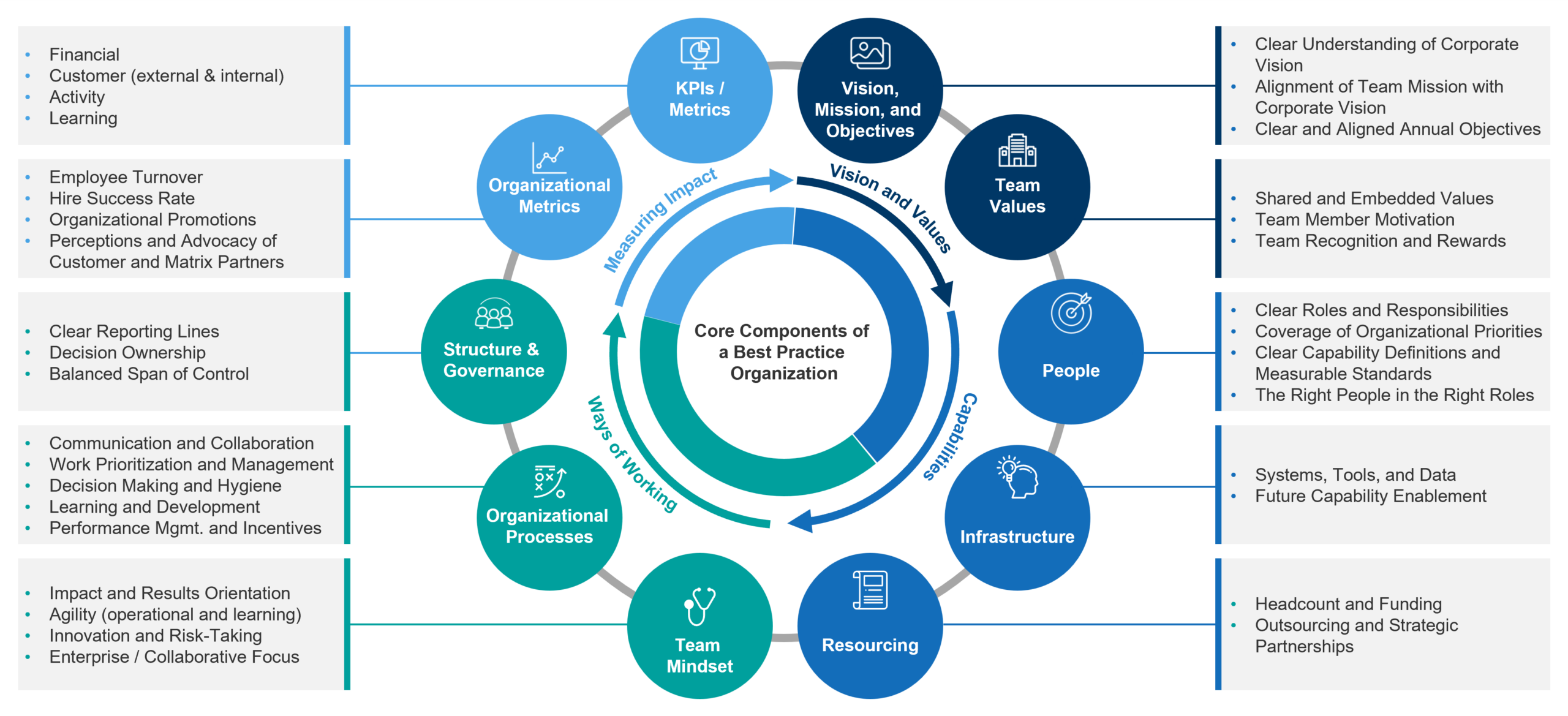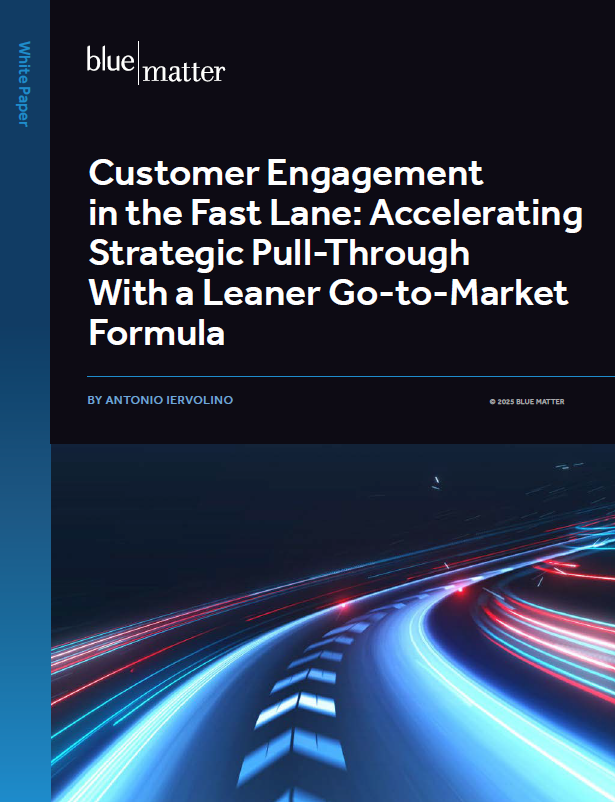
There’s no doubt that some industries are more challenging than others. In some industries, the pace of change is somewhat leisurely, regulatory oversight is light, and the competition is limited. Even in an “easy” environment, though, a company should always seek ways to improve its performance, effectiveness, and efficiency. In short, it should try to be the best organization that it can possibly be within its space, as that’s the pathway to optimizing value.
The biopharmaceutical industry is not one of those “easy” environments. It never has been. However, it has gotten even more challenging in recent years and will continue to do so. For biopharma companies, building and maintaining the best possible organization is not just a “nice-to-have.” It’s an absolute necessity.
This series of articles, which we’ll be publishing throughout the first part of 2024, will focus on helping biopharma companies determine how to build the type of organization that is so important in today’s life science industry. Our term for this is a Best Practice Organization.
Here, in part 1, we define “Best Practice Organization” and explain what it means to be one. We also outline several reasons why it’s important to be a Best Practice Organization (BPO) in today’s biopharma industry. Finally, we list the key components of a BPO, organizing them into four key categories, which we briefly describe.
Part 1 lays the groundwork for subsequent installments, which will explore each category and their components in more detail, weaving in case studies where needed to illustrate key concepts. In most cases, we leverage innovative examples from outside the life sciences, exploring how biopharma companies can employ the same concepts as they work to become Best Practice Organizations.
In a second series, we’ll incorporate business and commercial leader perspectives on the challenges organizations face, how those challenges make it difficult to become a Best Practice Organization, and the key success factors these leaders believe are critical to enabling a Best Practice Organization.
Overall, our goal is to provide insights and guidance that companies—as well as individual business units and functional teams—can use as they conduct strategic planning and organizational development activities. The concepts that we will share apply to emerging companies building organizations for the first time, as well as existing organizations seeking to optimize their performance in challenging environments.
Defining “Best Practice Organization”
Let’s start with the definition. A word of warning, though: at first glance, this definition might look like a buzzword-filled example of consultant-speak, but bear with it, as there is a reason for all this. Here goes:
A best practice organization is one that consistently demonstrates exceptional performance, effectiveness and efficiency to achieve its vision, mission, and strategic objectives.
Admittedly, it’s a little wordy. But, as they say, “Words mean things,” so let’s dissect it for just a moment. There are several aspects to organizational excellence that directly relate to an organization’s ability to create value. Performance is obviously critical. The organization must be focused on and actually do the work that’s needed to achieve its objectives in support of its vision and mission. Yet it goes beyond performing, as there are many examples of organizations performing well almost despite themselves (some airlines come to mind). The BPO must also work effectively (i.e., getting the job done well vs. just getting it done) and efficiently (delivering on those objectives with the optimal use of resources, whether measured in time, money, and/or other resources). Without all three aspects in place—performance, effectiveness, and efficiency—the organization will be leaving value “on the table.”
The definition also makes it clear that the term “organization” is not just referring to a company. While it certainly includes a company, any team can also work—at their own levels—to be a BPO. These can include strategic business units, as well as functional areas like Medical Affairs, Clinical Development, and Market Access. It can also include cross-functional teams (e.g., product core teams, launch teams, in-line brand teams) established for a particular purpose.
The BPO also performs and delivers on multiple levels. A company (and its constituent teams or functions) must deliver on the corporate vision. Yet, the teams must also deliver on their own missions (which should directly align to the overall corporate vision), achieve their strategic objectives related to their missions, and demonstrate excellence in the day-to-day operations that they execute in pursuit of those objectives. BPOs must do all of this while ensuring cross-functional/cross-BU collaboration. A breakdown at any of those levels can compromise an entire company’s ability to generate value.
Finally, to do all the things above, an organization must have the right capabilities and it must have proven ways of working (including governance processes) to make it all work.
Why the Biopharma Industry Requires Best Practice Organizations
As mentioned, the biopharma industry is not an easy place to be. A range of factors exist that are driving biopharma companies to continuously improve, making the concept of a BPO a necessity for success. Driving performance, effectiveness, and efficient resource allocations are increasingly critical for organizations to continue delivering scientific innovation in the face of increased competitive, regulatory, and pricing pressure. This trend will continue. Consider the following:
- Complexity is increasing, especially given the ongoing innovations in various rare diseases (RDs), oncology, and other specialty markets—including cell and gene therapies. These therapies often have complicated supply chains, administration processes, and access / reimbursement approaches.
- The increased complexity in RD, oncology and specialty markets makes delivering and maintaining customer satisfaction more challenging. In addition, the small customer bases in those markets, which can include patients and as well as other stakeholders, can magnify the negative implications of customer service lapses.
- Compliance and risk mitigation have become increasingly important and challenging to implement, given the increased complexity of therapies.
- Competitive advantages are harder to obtain and maintain.
- Employees are more mobile and have increasingly high expectations for personal and professional development, as well as flexible working arrangements, in the post-COVID world.
Given these and other factors, organizations need to be nimble and resilient. They must become learning organizations that are constantly evolving for change. Being a “Best Practice Organization” can be a path to competitive advantage, but it’s becoming a necessary component to organizational survival.
Key Components of a Best Practice Organization
There are many components that go into making a BPO, as shown in Figure 1.
Figure 1 – Best Practice Organizational Design Framework
As this series progresses, we’ll explore the components in Figure 1 in more detail. For now, however, it’s important to note that those components fall into four basic categories. Table 1 provides a quick look at each category.
Table 1 – Four Categories of Best Practice Organization Components
| Vision, Mission, and Values | Best Practice Organizations align the company, business units, and functional areas to strong organizational vision, mission, and values. This helps ensure that execution—at all levels—drives toward the long-term objectives that leadership has set. An organization’s vision, mission, and values include the shared beliefs, attitudes, and behaviors that create the “personality” of a company, business unit, or function. That personality must be consistent with and complementary to the overall vision. |
| Capabilities | Having the right capabilities starts with having the right people with the right skills, knowledge, and behaviors in the right roles. Companies should ensure full and effective coverage of workload associated with organizational priorities, while also forecasting and planning for workload shifts if priorities change. Given how dynamic the industry is, organizations should consider how to incorporate strategic partnerships and outsourcing to fill strategic and operational gaps. Beyond team members, capabilities also include processes, systems, tools, and data to meet current and future organizational, patient, and customer needs. As companies become more and more digitally enabled, these capabilities will often be the difference between being an industry leader or being left behind. |
| Ways of Working | Best Practice Organizations have effective governance with well-designed structures, clear reporting lines and decision ownership, proper incentives, as well as appropriate spans of control. There is an ongoing tension between having everything clearly defined, while also ensuring the organization can shift and flex to meet emerging priorities. To overcome this tension, a BPO must foster the right mindsets to enable teams to be open to change, to collaborate and work across the enterprise, and to look for opportunities to innovate and take risks. |
| Measuring Impact | Effective measurement is essential to a BPO. This measurement is important at different levels:
|
Coming Next
In part 2, we’ll explore Vision, Mission, and Values in more detail. For many, a “vision” is just a statement that gets shared once at a meeting and is then forgotten. But in reality, a clear and well-articulated vision provides the basis for everything a company does, and enables the definition of a clear mission to guide planning and operational efforts. We’ll explore why strong vision, mission, and values are so important and how to create them.








